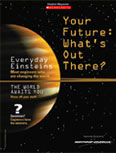  |
| >Mission: Define Your Future home | |||
| Lesson 2: Intelligent Vehicles Goal: Understand how human abilities, qualities, and habits are enhanced by technology such as remotely operated planes and other exploratory vehicles. Time Required: 40 minutes Directions: 2. Introduce the Global Hawk (www.af.mil/factsheets/factsheet.asp?fsID=175) as one example of an unmanned plane that is used to survey regions that are too dangerous for humans to explore, find missing people or vehicles, and survey/search in dangerous weather or enemy terrain. 3. Have students think about why it might be beneficial to use an unmanned aircraft (e.g., can help humans learn about the oceans, the hottest volcanoes, or other places that are too dangerous or small to visit). 4. Distribute Intelligent Vehicles Student Reproducible 2 (PDF) and discuss and answer the questions as a class:
Photo: © Denis Scott/Taxi/Getty Images.
|
Student Magazine Your students can meet engineers who are changing the world each day! These engineers have mastered math and science to improve the way we live. Now it's your students' turn. What will they do? Challenge them to improve the world. • Your Future: What's Out There? Find Out Now (PDF) Generously sponsored by: |
||
